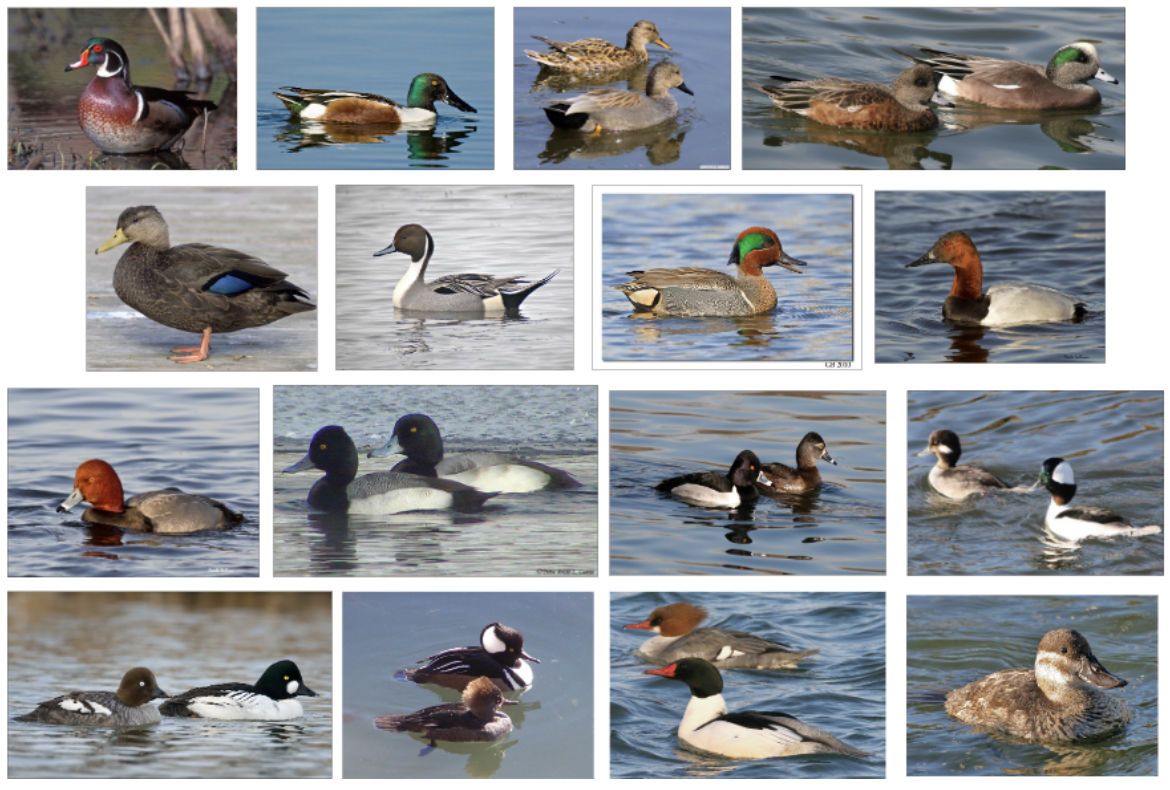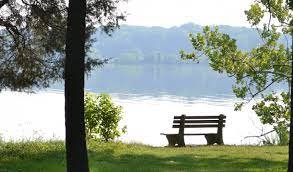Everyone loves ducks. One of my earliest interactions with birds was going to the pond to feed the ducks. (PSA: Don’t feed them bread, or anything actually. More on why not here.)
In the Birding world, winter is known as “Crazy Duck season.”
Comic by Rosemary Mosco, Birdandmoon.com
Yes! Exciting news - there are 16+ species of ducks that live or visit Northern Virginia. A duck is a type of waterfowl with a broad blunt bill, webbed feet and a waddling gait.
In the photo above, we have (from left to right), the following ducks:
Wood Duck
Northern Shoveler
Gadwall
American Wigeon
American Black Duck
Northern Pintail
Green-winged Teal
Canvasback
Redhead
Greater and Lesser Scaup
Ring-necked Duck
Bufflehead
Common Goldeneye
Hooded Merganser
Common Merganser
Ruddy Duck
There are also some not-ducks that may look a bit like ducks!
American Coot
Pied-billed Grebe
Horned Grebe
Red-necked Grebe
Learn More About Ducks
If you want to learn how to identify these ducks and other winter waterfowl, join our webinar, Ducks and Waterfowl Identification with Greg Butcher on February 2, 2023 and our field trip on Feb 4, 2023. If you really want to nerd out about ducks with the experts, sign up for our Winter Waterfowl Count on Feb 11-12 as a volunteer citizen scientist!
So, now you know the ducks and not-ducks - where should you go looking for them?
Our team of Bird Nerds recommend the following 5 places:
5. Pohick Bay Regional Park, Lorton, VA (Fishing Launch Area)
Photo: Fairfax Parks Department
Pohick Bay is a water-oriented park 25 miles south of the nation's capital. The park occupies a spectacular bayside setting on the historic Mason Neck peninsula in Fairfax County. In early times, George Washington visited the area frequently.
On ecologically fragile land, Pohick Bay Regional Park shelters an abundance of animals, including the bald eagle. Nature lovers can expect to see bluebirds, osprey, heron, deer, beavers and rare sightings of river otters. The park offers activities such as guided canoe and kayak tours that get you up close and personal with some of the wildlife seen here.
Pohick Bay is a good place to spot Gadwalls and Pintails.
Read more here.
4. Elizabeth Hartwell Mason Neck National Wildlife Refuge NWR, Lorton, VA
Photo: Wikipedia user Fredlyfish4
This one requires a walk to get down to the viewing platform, but it’s worth it, especially if you can bring a scope or a bird nerd friend with a scope.
Elizabeth Hartwell Mason Neck National Wildlife Refuge is a National Wildlife Refuge of the United States located in Virginia. It is part of the Potomac River National Wildlife Refuge Complex. It is on Mason Neck, a peninsula in the Potomac River that forms part of the shoreline of Belmont Bay. The refuge is adjacent to Mason Neck State Park.
Established in 1969 and managed by the United States Fish and Wildlife Service, it was the first federal refuge created specifically for the protection of the bald eagle. It is 2,277 acres (9.21 km2) in size, with 4.4 miles (7.1 km) of shoreline. It is covered with oak and hickory forest and it includes the largest freshwater marsh in northern Virginia.
Since its founding, the refuge has been renamed for Elizabeth S. Hartwell, a local activist who fought to keep Mason Neck free of development.
Hartwell is a good place to look for Tundra Swans, American Black Ducks (in the Great Marsh) and Lesser Scaup (in the river).
Learn more here.
3. Neabsco Regional Park, Woodbridge, VA
Photo: Visit Prince William Virginia
THE NEABSCO CREEK BOARDWALK is a ¾-mile boardwalk that traverses Neabsco Creek, allowing hikers access to wetlands where the tall grasses and marsh filter pollution from the river and provide a rich habitat for great blue herons, wood ducks, mallards, sparrow and red-winged blackbirds, just to name a few of the winged wildlife known to populate the area.
The walkway is part of the POTOMAC HERITAGE NATIONAL SCENIC TRAIL, which was established by Congress in 1983 designating an 800-mile trail network stretching from the Allegheny Mountains in Pennsylvania to the Potomac River, winding through Pennsylvania, Maryland, Washington, D.C. and Virginia.
The boardwalk is part of NEABSCO REGIONAL PARK and showcases Woodbridge's most valuable natural asset -- the Potomac waterfront – while linking historic landmarks such as Rippon Lodge and Leesylvania Park. The boardwalk is ADA compliant and encompasses educational sites that highlight information on native wildlife and plants.
Neabsco Creek can be a good place to see Ruddy Ducks and American Wigeon.
Read more here.
2. Riverbend Regional Park, Great Falls, VA
Photo: Live and Let Hike
This park consists of a mature deciduous forest bordering the Potomac River. This stretch of the river is an interesting counterpoint to the drama of Great Falls. Rock islands interspersed in the river provide beautiful contrast to the placid flow of the river.
An extensive trail system and a visitor center provide excellent facilities to enhance wildlife viewing. This site provides excellent opportunities for viewing eastern deciduous bird species in the fall and spring, and waterfowl along the Potomac River in winter. A 14-acre tall grass meadow provides viewing opportunities for songbirds and butterflies. Bald eagle and osprey are two of the typical birds found here. Extensive butterfly gardens around the visitor center provide good viewing opportunities as well.
For wildlife viewing by water, canoe and kayak rentals are available seasonally (May – October).
Riverbend is a good place to see Ring-necked Ducks and Common Mergansers.
More info here.
1. Huntley Meadows Park, Alexandria, VA
Photo: Judy Gallagher
This is the crown jewel of birding in Northern Virginia, as in, this parking lot is FULL every Saturday and Sunday morning during prime birding time (spring & fall migration) and is worth a visit even in the dead of winter.
Huntley Meadows Park protects over 1,500 acres of breathtaking forested and open wetland areas. Huntley Meadows is a natural depression surrounded by urban development. This area is important for both wildlife and water quality, providing a natural filter for suburban run-off. Be sure to visit the nature center before exploring the park. The park offers handicap accessible trails, boardwalks, and viewing platforms.
The forest hosts a broad diversity of breeding, migrant, and wintering birds. Yellow-billed cuckoo, prothonotary warbler, red-shouldered hawk, Acadian flycatcher, eastern wood-pewee, and red-headed woodpecker breed in these woods during summer months. Year-round avian residents include barred owl, great horned owl, pileated woodpecker, and wild turkey.
This is also a prime spot to see all the coolest ducks, and due to the park’s geography, you get great close-up looks at species like Hooded Mergansers, Green-winged Teals, Northern Pintails, Northern Shovelers and more.
More info here.
As a reminder, wherever you go looking for ducks, please follow the ABA birding code of ethics.
P.S. Get Cool Pics of Ducks
For photographers - get all the info you need to take your bird photography to the next level! Ducks make a great photography subject - they are pretty large compared to most birds and tend to stay still long enough to get a good shot. Join Matt Felperin’s Bird Photography Workshop on Feb 21 and his field trip on Feb 25 (warning: it’s super early in the morning).
Now go forth and find ducks!








